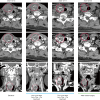Neoadjuvant therapy and surgical resection successfully treating primary thyroid squamous cell carcinoma: a case report
- PMID: 40771383
- PMCID: PMC12322765
- DOI: 10.21037/gs-2025-88
Neoadjuvant therapy and surgical resection successfully treating primary thyroid squamous cell carcinoma: a case report
Abstract
Background: Primary squamous cell carcinoma of the thyroid is a rare, highly lethal malignancy, comprising less than 1% of all thyroid cancers. It is associated with poor prognosis due to its rapid progression, resistance to conventional therapies, and frequent presentation at an advanced stage. The preferred treatment approach combines surgical resection with adjuvant radiotherapy or chemotherapy, yet outcomes remain unsatisfactory.
Case description: We report a case involving a 69-year-old female who presented with a progressively enlarging mass in the anterior neck. Computed tomography (CT) scans identified a right thyroid nodule measuring 4.0 cm × 4.7 cm × 5.3 cm. Subsequent fine needle aspiration biopsy confirmed thyroid squamous cell carcinoma, with molecular analysis revealing a positive BRAF (exon15:c.1801A>G:p.K601E) mutation. Given the substantial size of the neck mass and the unsuitability for surgical resection, neoadjuvant therapy was initiated. This included a combination of tislelizumab immunotherapy, chemotherapy, and anlotinib targeted therapy, which significantly reduced the size of tumor. The patient subsequently underwent a total thyroidectomy and remained disease-free for 2 years.
Conclusions: The present case demonstrates the potential of a multimodal treatment regimen encompassing chemotherapy, immunotherapy and targeted therapy, followed by surgical excision, for primary thyroid squamous cell carcinoma. Further studies are needed to validate the efficacy and safety of this combined treatment modality in larger patient populations.
Keywords: Thyroid squamous cell carcinoma; anlotinib; case report; neoadjuvant therapy; tislelizumab.
Copyright © 2025 AME Publishing Company. All rights reserved.
Conflict of interest statement
Conflicts of Interest: All authors have completed the ICMJE uniform disclosure form (available at https://gs.amegroups.com/article/view/10.21037/gs-2025-88/coif). The authors have no conflicts of interest to declare.
Figures


Similar articles
-
Impact of residual disease as a prognostic factor for survival in women with advanced epithelial ovarian cancer after primary surgery.Cochrane Database Syst Rev. 2022 Sep 26;9(9):CD015048. doi: 10.1002/14651858.CD015048.pub2. Cochrane Database Syst Rev. 2022. PMID: 36161421 Free PMC article.
-
Systemic treatments for metastatic cutaneous melanoma.Cochrane Database Syst Rev. 2018 Feb 6;2(2):CD011123. doi: 10.1002/14651858.CD011123.pub2. Cochrane Database Syst Rev. 2018. PMID: 29405038 Free PMC article.
-
Minimally invasive surgery versus radiotherapy/chemoradiotherapy for small-volume primary oropharyngeal carcinoma.Cochrane Database Syst Rev. 2016 Dec 11;12(12):CD010963. doi: 10.1002/14651858.CD010963.pub2. Cochrane Database Syst Rev. 2016. PMID: 27943254 Free PMC article.
-
Hysterectomy with radiotherapy or chemotherapy or both for women with locally advanced cervical cancer.Cochrane Database Syst Rev. 2015 Apr 7;(4):CD010260. doi: 10.1002/14651858.CD010260.pub2. Cochrane Database Syst Rev. 2015. Update in: Cochrane Database Syst Rev. 2022 Aug 22;8:CD010260. doi: 10.1002/14651858.CD010260.pub3. PMID: 25847525 Updated.
-
Neoadjuvant treatment for stage III and IV cutaneous melanoma.Cochrane Database Syst Rev. 2023 Jan 17;1(1):CD012974. doi: 10.1002/14651858.CD012974.pub2. Cochrane Database Syst Rev. 2023. PMID: 36648215 Free PMC article.
References
Publication types
LinkOut - more resources
Full Text Sources
Research Materials
